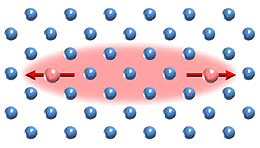Research Abstract
半導体における核スピン–スピン相互作用の光スイッチング
エンタングルメントの時間発展を制御する「二量子ビット操作」は、量子計算の重要な要素である。その実現には量子ビット間の相互作用(結合)をスイッチ操作する必要があるが、固体NMR量子コンピューターでこの機能を実現することは容易ではない。
Optical switching of nuclear spin–spin couplings in semiconductors
2011年7月5日 Nature Communications 2 : 378 doi: 10.1038/ncomms1378

エンタングルメントの時間発展を制御する「二量子ビット操作」は、量子計算の重要な要素である。その実現には量子ビット間の相互作用(結合)をスイッチ操作する必要があるが、固体NMR量子コンピューターでこの機能を実現することは容易ではない。例えば、核双極子相互作用は、近接した量子ビット(= 核スピン)間には常に存在するため便利ではあるが、逆に、計算操作を行わない時に不必要な相互作用を除去し続ける必要があり、二量子ビット操作はかなり複雑で難しい作業となる。今回我々は、半導体において光により制御可能な核スピン間相互作用を見いだしたので報告する。その相互作用の強度は、照射する光の強度を調節することにより制御可能であり、オン・オフ操作も容易に実現できる。これは、半導体をベースとしたNMR量子コンピューターにおいて、量子ビット間結合をスイッチ操作するための手段を与える。さらに、この相互作用は核双極子相互作用よりも到達距離が長く、相互作用の確保のために量子ビットを近接させる必要がない。このことは、量子ビットの配列に大きな自由度をもたらす可能性がある。
- 独立行政法人 物質・材料研究機構
- 独立行政法人 科学技術振興機構
Two-qubit operation is an essential part of quantum computation. However, solid-state nuclear magnetic resonance quantum computing has not been able to fully implement this functionality, because it requires a switchable inter-qubit coupling that controls the time evolutions of entanglements. Nuclear dipolar coupling is beneficial in that it is present whenever nuclear–spin qubits are close to each other, while it complicates two-qubit operation because the qubits must remain decoupled to prevent unwanted couplings. Here we introduce optically controllable internuclear coupling in semiconductors. The coupling strength can be adjusted externally through light power and even allows on/off switching. This feature provides a simple way of switching inter-qubit couplings in semiconductor-based quantum computers. In addition, its long reach compared with nuclear dipolar couplings allows a variety of options for arranging qubits, as they need not be next to each other to secure couplings.

